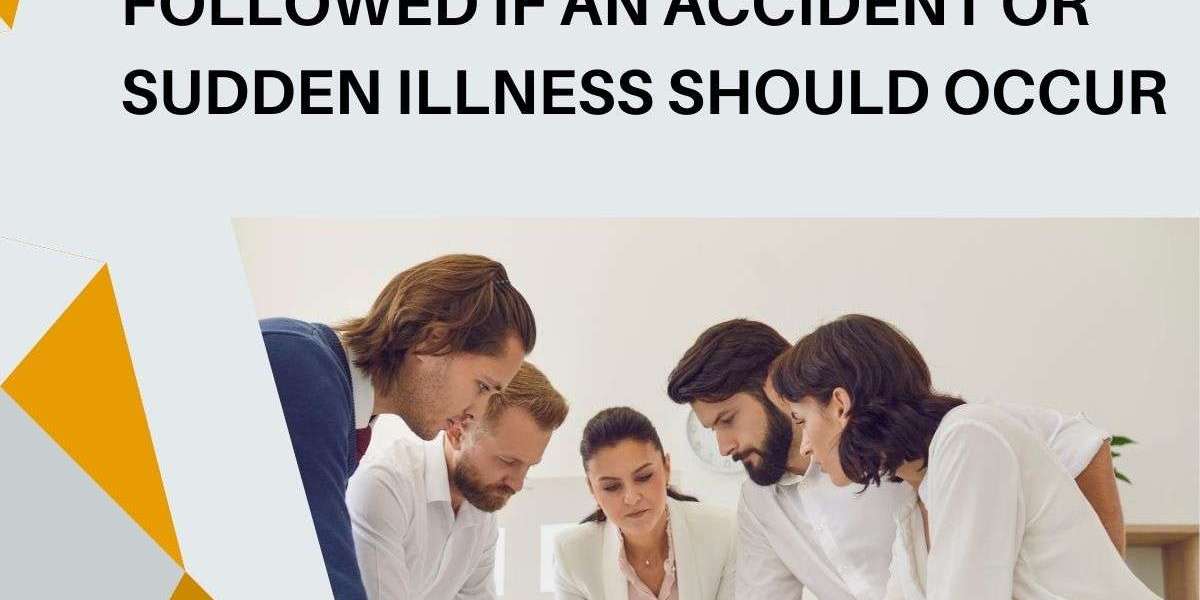Accidents and sudden illnesses can happen unexpectedly and often require prompt action to prevent further harm. Knowing essential first aid procedures can make a significant difference, helping to stabilize the individual until professional help arrives. What should you do if an accident or sudden illness should occur at work? This guide covers the critical steps and first aid essentials needed to effectively manage common accidents and sudden illnesses. Being prepared with this knowledge empowers us to provide lifesaving care in emergencies.
Why First Aid Knowledge is Crucial
The initial moments following an accident or the onset of a sudden illness are crucial. First aid serves as the first line of support, mitigating injuries, reducing pain, and in some cases, saving lives. Familiarity with basic first aid procedures allows us to act effectively in high-stress situations, addressing problems such as airway obstructions, severe bleeding, heart attacks, and strokes. Below, we detail key procedures for handling different emergency scenarios.
Common First Aid Procedures
1. First Aid for Bleeding and Wounds
Wounds vary in severity and can result from accidents such as cuts, falls, or other traumatic events. Addressing bleeding quickly is critical to prevent blood loss and infection.
- Assess the Wound: Check for the depth and location of the wound. Large or deep wounds may require urgent medical attention.
- Apply Direct Pressure: Use a sterile gauze pad or a clean cloth, applying firm pressure directly on the wound. This helps slow or stop bleeding.
- Elevate the Limb: If the wound is on a limb, elevate it above heart level to reduce blood flow to the area.
- Clean the Wound: Once bleeding is controlled, gently clean the wound with antiseptic to minimize infection risk.
- Bandage Properly: Cover the wound with a sterile bandage, ensuring it is snug but not so tight as to restrict circulation.
- Monitor for Infection: Keep an eye on signs of infection, such as redness, swelling, or warmth, and seek medical advice if these symptoms appear.
2. CPR (Cardiopulmonary Resuscitation)
Cardiopulmonary Resuscitation (CPR) is a lifesaving procedure, essential in cases of cardiac arrest. CPR keeps oxygenated blood circulating to the brain and vital organs, increasing the chances of survival until emergency medical services arrive.
- Check Responsiveness and Breathing: Tap the person gently and shout to check responsiveness. Observe for normal breathing.
- Call for Help: Call emergency services immediately if the person is unresponsive and not breathing.
- Start Chest Compressions:
- Hand Placement: Place one hand over the other and interlock the fingers, positioning them in the center of the chest.
- Compression Technique: Press down firmly and quickly, aiming for a depth of 2 inches, at a rate of 100-120 compressions per minute.
- Rescue Breaths: After 30 compressions, give two rescue breaths if you are trained to do so.
- Continue Until Help Arrives: Continue CPR until professional help arrives or the person regains consciousness.
3. First Aid for Burns
Burns can be extremely painful and, in severe cases, may lead to lasting damage. First aid for burns depends on the severity of the burn and the area affected.
- Assess the Burn Severity:
- First-Degree Burns: Redness and minor swelling.
- Second-Degree Burns: Blistering and intense pain.
- Third-Degree Burns: White or charred skin with severe tissue damage.
- Cool the Burn: Run cool (not cold) water over the burn for 10-15 minutes to reduce pain and swelling.
- Avoid Ice and Ointments: Do not apply ice or butter to burns, as this can worsen tissue damage.
- Cover with a Sterile Bandage: Lightly cover the burn with a sterile bandage or clean cloth to protect the area.
- Seek Medical Attention: For burns larger than a few inches, or burns on the face, hands, feet, or groin, consult medical professionals.
4. Choking Relief for Adults and Children
Choking can occur unexpectedly, blocking airflow and requiring immediate action. Knowing the Heimlich maneuver and other choking first aid techniques is vital.
- Encourage Coughing: If the person can still cough, encourage them to continue coughing to dislodge the object.
- Perform the Heimlich Maneuver:
- For Adults: Stand behind the person, wrap your arms around their waist, make a fist, and place it above the navel. Perform quick upward thrusts.
- For Infants: Place the infant facedown on your forearm and give up to five back slaps between the shoulder blades.
- Continue Until the Airway is Clear: Repeat until the object is expelled or the person loses consciousness, at which point CPR should begin.
5. First Aid for Heart Attack
Heart attacks are a leading cause of sudden death and require immediate response to improve survival chances.
- Recognize Symptoms: Symptoms include chest pain, shortness of breath, sweating, and discomfort in the arm, neck, or jaw.
- Call Emergency Services Immediately: If a heart attack is suspected, call for medical help without delay.
- Provide Aspirin if Available: If the person is not allergic, give them one aspirin to chew, as it helps thin the blood.
- Help the Person to a Comfortable Position: Keep them calm and seated to reduce heart strain.
- Monitor and Prepare for CPR: Be ready to perform CPR if the person becomes unresponsive.
6. First Aid for Strokes
A stroke occurs when blood flow to the brain is interrupted. Rapid intervention can prevent permanent damage.
- Identify Stroke Symptoms Using FAST:
- Face Drooping: Ask the person to smile; one side may droop.
- Arm Weakness: Ask them to raise both arms; one may drift downward.
- Speech Difficulty: Ask them to repeat a simple phrase; slurred speech may indicate a stroke.
- Time to Call Emergency Services: Call for medical help immediately.
- Keep the Person Comfortable: Lay the person down with their head elevated and calm them to reduce stress on the brain.
- Do Not Give Food or Drink: Avoid giving anything by mouth, as swallowing ability may be impaired.
7. First Aid for Seizures
Seizures can be caused by various factors, including epilepsy, head injuries, or infections. Knowing how to respond can protect the individual from further harm.
- Protect from Injury: Clear the surrounding area of any objects that could cause injury.
- Do Not Restrain: Avoid holding the person down, as this can cause harm.
- Place Them on Their Side: Once the seizure stops, position them on their side to help clear their airway.
- Check Breathing and Responsiveness: If the seizure lasts longer than five minutes, or if the person has difficulty breathing, seek medical assistance immediately.
Essential First Aid Kit Items
A well-stocked first aid kit ensures that we are prepared for common injuries and emergencies. Key items include:
- Sterile Gauze Pads and Bandages: For covering and protecting wounds.
- Antiseptic Wipes: To clean wounds and reduce infection risk.
- Adhesive Tape: For securing bandages.
- Thermometer: For checking temperature during illness.
- Tweezers: To remove splinters or small debris.
- CPR Mask: To safely administer rescue breaths.
- Pain Relievers: For managing mild pain and fever.
- Scissors: For cutting tape and dressings.
- Instant Cold Packs: For swelling and sprains.
- Gloves: For hygiene and protection against infections.
Regularly check your first aid kit for expired items, and keep it in an accessible place in your home, car, or workplace.
Having a strong foundation in first aid procedures and maintaining a prepared mindset can make all the difference in emergencies. Whether facing minor injuries or life-threatening situations, these skills allow us to offer immediate support until professional help arrives, enhancing the safety of those around us.
Conclusion
Knowing first aid essentials equips us to respond confidently and effectively during accidents or sudden illnesses. These skills can significantly reduce the severity of injuries, prevent complications, and even save lives. By understanding and practicing procedures like CPR, managing bleeding and burns, and recognizing signs of heart attacks or strokes, we can make crucial contributions in emergency situations. Preparing a well-stocked first aid kit and keeping it accessible also enhances our readiness to act swiftly. Prioritizing first aid knowledge is a powerful way to ensure safety and support those around us in critical moments.



